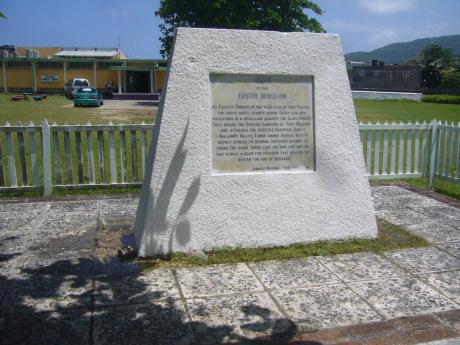Kristen Gyles | A tacky history of disunity
In the very early morning of Easter Monday, April 8, 1760, a group of about 100 enslaved Africans stormed the Fort Haldane port of trade in Saint Mary, killing the watchman who guarded the entrance to the building. They raided the building and took roughly 40 guns, gunpowder and other weapons, equipping themselves for the war they planned to wage against not only their own enslavers but against the slave trade as a system.
The company of Africans had already made its attack on the Frontier and Trinity plantations, killing anyone who they thought would be an obstacle to their mission. Having been sufficiently armed to continue the fight, they moved along to the Ballard’s Valley estate where they killed roughly 12 whites and even more non-whites who stood in their way. They moved on to the Esher plantation and overthrew it, garnering support from other enslaved Africans as they progressed. The group then moved on to the Whitehall estate and then on to Heywood Hall estate where they set fire to the cane field signalling the perceived success of their insurrection.
Who exactly were these people? They were the angry and vexed company of rebellious enslaved Africans who, according to witnesses, were led by a Guinean Chief called Tacky. Tacky was a military-trained coromantee from the Fante tribe of the Gold Coast. He was sold into slavery but was quickly put in the position of overseer on the Frontier plantation. There, he was able to strategise and make informed plans in furtherance of his ultimate goal – freedom.
Anyway, the story did not quite end in victory. While Tacky’s men were making their attack on the Esher estate, a slave named ‘Yankee’, who fought to defend the whites, escaped to a neighbouring plantation and teamed up with another slave there to sound the alarm to neighbouring plantations that there was an uprising.
QUICK RESPONSE
Naturally, this triggered a quick response from the planter class and in no time an armed group of enslavers and their sympathisers caught up with the enslaved. Word of the rebellion got to the colonial government and letters were quickly dispatched to officers stationed near maroon villages to bring the maroons into the fight in accordance with the 1739 and 1740 treaties they had signed. Help was also enlisted from commoners, who were ordered to fight in defence of the enslavers.
The initial fight continued over several days and at some point a group of maroons engaged Tacky and his army in direct combat. Many of Tacky’s men were killed, some returned to their plantations and others committed suicide after deciding that they would never go back into slavery. One British soldier who was with the maroons shot and killed Tacky and beheaded him. Tacky’s head was placed on a pole in Spanish Town and eventually taken down during the night by his followers.
The story of Tacky’s Rebellion can be found in Tacky’s Revolt: The Story of an Atlantic Slave War written by Harvard Professor, Vincent Brown.
So, why the recounting of this story one day after we celebrate the anniversary of our emancipation from slavery? First, because the story of Chief Tacky and his men has got lost in our dependence on those who enslaved our ancestors to teach us about our own history and ancestry. Second, because it makes a valuable point that we would do well to think on over the ‘emancipendence’ period. That point surrounds the power of disunity in derailing joint goals, whether nationally or at the community level.
FREE PEOPLE SOONER
As it appears, our ancestors could have been a free people much sooner were it not for the efforts of traitors who were hell-bent on securing their own personal interests at the expense of collective freedom. Why would a slave fight to protect the ‘master’ who he sees brutalising his fellow African brothers and sisters daily? Because he is foolishly hopeful of some rich reward – even if the rich reward is commendation from a man who sees him as three-fifths of a human.
It is quite like how some criminal dons and gang leaders will never be caught, because of the support they enjoy from loyalists like Yankee. Every time someone in the community tries to alert the authorities to the activity of these gangbangers who have the whole community enslaved, some Yankee runs back to the don to inform on the informant, ironically.
Although the story of Chief Tacky is one that has faded into obscurity over the years, the 1760-1761 Tacky Rebellion is regarded as the largest slave rebellion in the history of the slave trade. It could have worked … but it didn’t … just like the many other uprisings that failed because of those both within and without the camp of the enslaved, who made it their duty to keep the wheels of the slave system turning.
While one may be responsible for inciting a movement of any kind, it takes many to see it through to success, and yet it can take only one to undo all the efforts of the many.
It is the same today. Do we work together to achieve the long-term goals we say we want to achieve as a country or are we more interested in the temporary comforts of individualism? How about the temporary successes of our own private enterprises? Or the temporary successes of our respective political parties? Achieving unity has been one of our greatest challenges since the days of Tacky, but before we make any progress, we will have to first be willing to put aside our differences and work together in achieving our shared goals as Jamaicans.
Kristen Gyles is a free-thinking public affairs opinionator. Send feedback to kristengyles@gmail.com and columns@gleanerjm.com.

